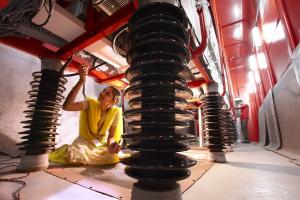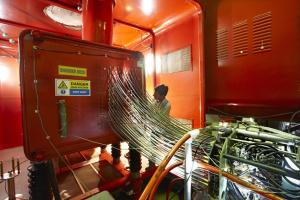Development of ITER's diagnostic neutral beam
9 Jul 2010
-
Arun K. Chakraborty and Indranil Bandyopadhyay, ITER India
Technicians are seen busy in providing the final installations of 50 kV electrical isolators for the assembly housing the gas feed system.
ITER India is responsible for the procurement of the diagnostic neutral beam, which will play the very important role of helping to detect the amount of helium ash inside of the ITER Tokamak. It will do so through charge exchange spectroscopy (CXRS), which is a measure of the efficiency of the fusion reactions in the device.
The diagnostic neutral beam will consist of a negative ion source-based neutral beam of hydrogen atoms with 100keV of energy and 17-20A of beam current with a divergence not exceeding ~7millirad. India has already signed the Procurement Arrangement for the delivery of this key component. At present, the detailed engineering design and R&D for the diagnostic neutral beam system is ongoing.
The diagnostic neutral beam will consist of a negative ion source-based neutral beam of hydrogen atoms with 100keV of energy and 17-20A of beam current with a divergence not exceeding ~7millirad. India has already signed the Procurement Arrangement for the delivery of this key component. At present, the detailed engineering design and R&D for the diagnostic neutral beam system is ongoing.
A dedicated assembly group have participated with infectious enthusiasm in the assembly and integration of the injector.
Strong support for the development of the system will be provided by the ongoing activities in the domestic neutral beam program, such as the positive ion-based injector that is mandated to deliver about 1.7 MW of NB power to the SST-1 Tokamak under steady state conditions (1000 s). This activity has been strongly supported by the Indian industries involved in development of technologies related to electrical and mechanical engineering hardware—many of them state-of-the-art. A dedicated assembly group has participated with infectious enthusiasm in the assembly and integration of the injector.
The complex task is performed by a set of controllers which are integrated through fiber optic or hard-wired cabling.
The first quarter of 2010 witnessed the campaign for the first phase of operation of an integrated system with the 5 MW ion source. Technicians are busy providing the final connections to the filaments and carrying out the final installations of 50 kV electrical isolators for the assembly housing the gas feed system.
The success in operating ion sources can be largely attributed to effective control of the discharge current. This complex task is performed by a set of controllers that are integrated through fibre optic or hard wired cabling. The positive ion injector is now in its final stages of integration with the cryosystem and will soon be available to the engineers for the commissioning of a full power beam.
In parallel, a negative ion source R&D program has also been undertaken at the Institute for Plasma Research (IPR), with the goal of successfully operating the BATMAN-type radio frequency ion source at IPR for operation, training and physics experiments. Up to 100 kW of radio frequency power can be coupled to the source to produce ~10 A of —ve ion beam in hydrogen at an accelerating voltage of ~ 25 kV. An engaged team of technicians is currently performing the pre-commissioning integration checks on the radio frequency integration, pre-integration checks for vacuum sub-assemblies and integration of control systems.
The plasma source has just been commissioned with 85 kW of radio frequency power coupled to the plasma. The program will be expanded to include creation of facilities for tests of larger sources, ultimately converging towards the commissioning of a test facility in India for R&D of the ITER diagnostic neutral beam system to address the complex physics and technology aspects of the neutral beam systems.
The plasma source has just been commissioned with 85 kW of radio frequency power coupled to the plasma. The program will be expanded to include creation of facilities for tests of larger sources, ultimately converging towards the commissioning of a test facility in India for R&D of the ITER diagnostic neutral beam system to address the complex physics and technology aspects of the neutral beam systems.





